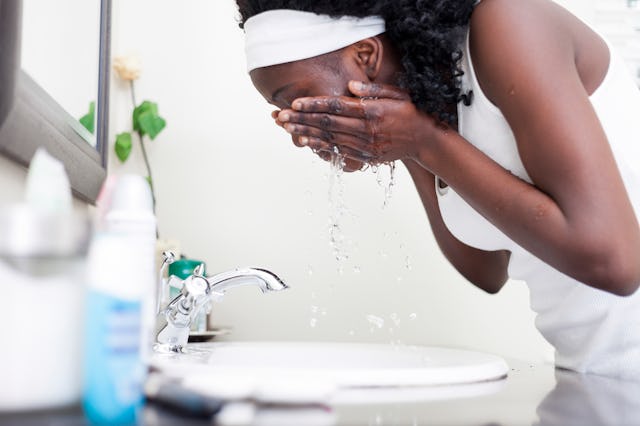Should Your Teen Try Skin Cycling?
A dermatologist weighs in on the safety and effectiveness of this TikTok trend.

Skin cycling is all the rage these days, with beauty aficionados and dermatologists alike singing the praises of this practical approach to skincare on social media, which boasts 190 million views on TikTok alone. If you've got a teen at home who is beginning to wade into the waters of something resembling a skincare routine, you might be wondering if they should jump aboard the skin cycling train or if the trend is better suited to adult skin.
Dr. Geeta Yadav, board-certified dermatologist and founder of FACET Dermatology, broke it all down, telling Scary Mommy how you can adapt the skin cycling trend to suit your teen's unique skincare needs — and hopefully save them from the pain of trying products that aren't quite right for them.
First things first: What is skin cycling, anyway?
"Skin cycling is basically a fun marketing term that outlines most dermatologists' approach to a skincare regimen — rotating products in and out for maximum efficacy," says Yadav. Essentially, instead of using some of your more potent products — such as retinoids or exfoliators to help clear blemishes — every day, you'll give your skin a "rest" on certain days. In theory, this will help prevent irritation or product overload that can actually damage skin — a definite possibility for newbie skincare lovers (ahem, like your product-happy tweens and teens).
"For the first two days of skin cycling, you use active ingredients to promote cellular turnover, while the subsequent three days or so are used for recovery," says Yadav. "This method allows skin to adjust to more potent ingredients or formulas without reacting negatively or experiencing irritation."
Is skin cycling safe for tweens and teens?
Yadav gives the trendy method two thumbs up, as long as you adapt the process and products used to your kid's individual needs — more on that in a minute. "Tweens and teens can try skin cycling, though I wouldn't recommend using ingredients at the strength an adult might use, and they likely can use a shorter cycle," she says, recommending "one day active with two to three days recovery unless they plan on using two forms of acne-fighting ingredients."
Perhaps unsurprisingly, tween and teen skin is much different than more mature skin (hello, hormones!), which means you likely don't want your kid using products from your arsenal. "The cellular turnover rate of skin in young adults is much faster than it is for adults 30 and beyond, so they shouldn't need aggressive formulas," says Yadav. "However, supporting that cellular turnover can help keep skin clear and radiant, not to mention stave off signs of aging — though that's not something they should worry about."
How can they get started?
"Young adults can use a mild facial scrub or cleanser with an ingredient like salicylic acid to help gently remove dead skin cells and clear out pores, ideally once or twice a week," says Yadav. She recommends Neutrogena's Pink Grapefruit Oil-Free Acne Wash Scrub, a gentle foaming scrub that "combines physical exfoliants with salicylic acid to keep skin clear."
"Salicylic acid is also commonly found in face masks, which can be a nice way to treat skin while practicing self-care," she adds. "Another ingredient to look for when treating blemishes is benzoyl peroxide, which works by killing acne-causing bacteria. BP is more commonly found in face washes. These two ingredients should not be used together and should be used on alternate days to avoid skin irritation." Of course, you'll always want to patch test on a small area (such as the forearm) before your kid dives face-first into a product to hopefully help prevent any angry, inflamed reactions.
No matter your kid's skin type, Yadav says two crucial components should be used daily: moisturizer and sunscreen, both of which can help protect against environmental ickies (like sun damage) and pollution. "Tweens and teens will likely not need heavy or rich moisturizers that might be used on the 'recovery' days found in adults' skin cycling routines if they're not using prescription-strength topicals," says Yadav. "Applying lightweight, oil-free moisturizers morning and night daily will help skin stay balanced. Many teens believe that using moisturizer will make their skin oily, but the truth is that not applying moisturizer can cause skin to overcompensate for that dryness by producing too much oil."
"If their skin is feeling dry in the 'recovery' window, seek out moisturizers with ceramides and hyaluronic acid to help restore balance to the skin barrier," she adds. "And, of course, make sure they apply sunscreen every single day, even on cloudy days. Scrubs, salicylic acid, and benzoyl peroxide all make skin more sensitive to sun exposure — and sun damage is the leading cause of skin cancer and premature aging. Wearing SPF daily is an excellent habit to start as early as possible."
This article was originally published on